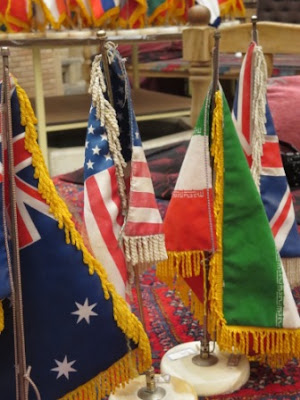After breakfast we left Zein o Din Caravanserai and began a leisurely drive towards Shiraz. Three monuments of the ancient Persian Empire were on our itinerary. We first visited Pasargadae, which was once the capital of the Achaemenid Empire under Cyrus the Great in the 6th century BC. A UNESCO World Heritage Site, the capital was in ruins and not much remains of the once glorious palaces and gardens. Cyrus' dramatic mausoleum still stands at Pasargadae though. Impressive in size and simplicity, Cyrus' tomb sat in an open, empty space dominating the surrounding agricultural fields.
We left Pasargadae and drove about an hour through green countryside to Naqsh-e Rustam, where four tombs of Achaemenid kings were located. The bright sunshine had given way to stormy skies and I struggled to keep my head scarf on my head while walking in the strong winds which swirled around the site.
The tombs of Naqsh-e Rustam were carved in the shape of "Persian crosses" high up on a soaring rock face. Visitors standing below were dwarfed by the immense scale of the massive site. One inscription identified the tomb of Darius the Great while the three remaining tombs are believed to belong to Xerxes, Artaxerxes and Darius II. The oldest of seven bas reliefs below the tombs dates from 1000 BC and is said to represent Rostam, the mythical hero of the epic Shahnameh by Ferdowsi. Sassanid kings are featured in scenes of coronation and conquest in the other carvings.
From Naqsh-e Rustam we drove about 8 miles to the grandest monument, "The City of Persians," Persepolis. The late afternoon rain that had started to fall, magically stopped when we arrived and I stood looking at the ruins from a distance before walking towards what was left of the ancient palaces.
A stairway of many low steps led to a huge raised terrace where immense buildings once sat. Now stone columns and doorways are all that remained. Alexander the Great (or as Milad liked to call him, Alexander the Not-So-Great) ordered Persepolis sacked to avenge the destruction of Greek temples by the Persians.
The stairways of the Apadana Palace featured bas relief carvings depicting guards, noblemen and dignitaries from all parts of the empire, each recognizable by their distinctive clothing and the gifts they brought. Milad also explained to us the symbolism of the carvings of the fighting bull and lion which represent the changing of the seasons from winter to spring.
The Gate of All Nations loomed over us at an impressive height of 54 feet. The winged guardian bulls formed a grand entrance even now. A closer look revealed centuries of graffiti carved into the stone, recording past visitors to what is now a UNESCO World Heritage site.
The sun was beginning to set when the announcement came over the loud speaker that Persepolis was closing and we must leave. We drove another 45 miles before finally reaching the last city on our tour: Shiraz-the city of poets, wine and flowers.

















































